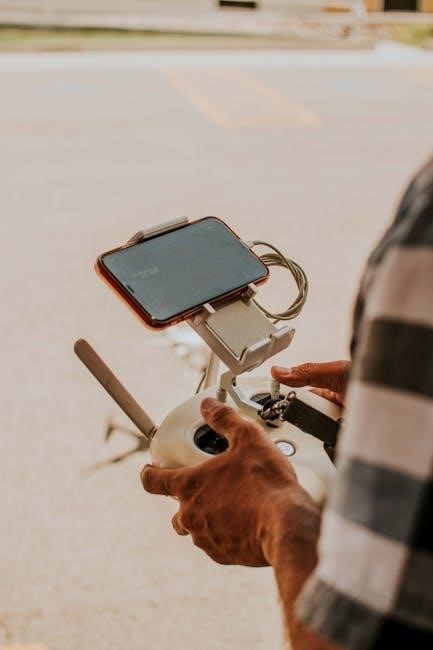manual for drone
Welcome to the Drone Manual, your comprehensive guide to understanding and mastering drone technology․ This manual covers everything from safety guidelines to advanced flight techniques, ensuring a smooth and enjoyable experience for all users․
1․1 Overview of Drone Technology
Drone technology has revolutionized industries, offering precise navigation, real-time data processing, and autonomous capabilities․ Modern drones integrate AI and machine learning to analyze sensory data, enabling advanced flight control and decision-making․ With models like the DJI Mavic 3 Pro, users can activate and operate drones seamlessly, leveraging features like GNSS and vision systems for stable flight․ This manual provides a detailed exploration of these technologies, ensuring safe and efficient drone operation․
1․2 Brief History of Drones
The history of drones dates back to the early 20th century, initially for military use․ Over the decades, advancements in technology transformed drones into versatile tools for recreation, photography, and industrial applications․ Early models were basic, but modern drones like the DJI Mavic 3 Pro now integrate AI and autonomous systems, revolutionizing their capabilities․ This evolution highlights the rapid growth of drone technology, from simple designs to sophisticated machines capable of complex tasks․
1․3 Types of Drones
Drones vary widely in design and purpose, ranging from recreational models like the DJI Mavic to industrial drones used for mapping and surveying․ RTK drones offer precise positioning for professional applications, while racing drones are built for speed and agility․ Additionally, autonomous drones leverage AI for self-navigation, and delivery drones are designed for transporting goods․ Each type serves unique needs, from hobbyist fun to complex industrial tasks․
1․4 Importance of a Drone Manual
A drone manual is essential for safe and effective operation, providing detailed guidance on assembly, configuration, and flight techniques․ It ensures compliance with legal requirements and enhances troubleshooting capabilities․ By following the manual, users can optimize performance, understand safety protocols, and maximize their drone’s potential․ Whether for recreational or professional use, a comprehensive manual is a vital resource for every drone enthusiast, ensuring a seamless and enjoyable experience․

Safety Guidelines
Safety Guidelines are crucial for drone operation, ensuring accident prevention and regulatory compliance․ They cover pre-flight checks, in-flight practices, and post-flight procedures to protect operators, bystanders, and the drone itself․
2․1 Pre-Flight Safety Checks
Before each flight, conduct thorough pre-flight safety checks to ensure safe and efficient operation․ Inspect propellers for damage, check battery levels, and verify GPS signal strength․ Ensure all hardware components are securely attached and functional․ Review weather conditions and avoid flying in strong winds or rain․ Check for firmware updates and ensure compliance with local regulations․ Always follow manufacturer guidelines to prevent accidents and ensure a smooth flight experience․
2․2 In-Flight Safety Tips
During flight, maintain constant visual line of sight with your drone and monitor altitude and battery levels․ Avoid flying near obstacles or restricted zones․ Use GPS and navigation systems to ensure stable flight․ Be aware of changing weather conditions and land immediately if unsafe․ Keep communication channels clear and avoid distractions․ Always be prepared for emergency landings by identifying safe landing zones in advance․
2․3 Post-Flight Safety Procedures
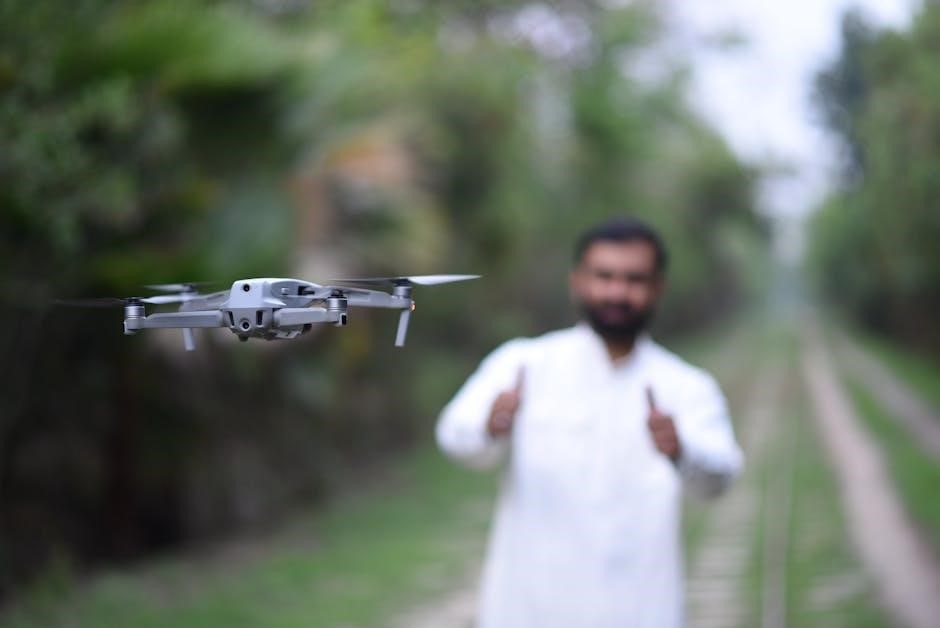
After landing, ensure the drone is completely powered down and disconnect the battery․ Inspect for damage or wear, especially on propellers and motors․ Review flight data to identify potential issues․ Store the drone in a dry, cool place, away from direct sunlight․ Regularly check and maintain battery health, and follow proper charging procedures․ Always log flight hours for future maintenance planning․ Adhere to these steps to ensure safety and longevity of your drone․
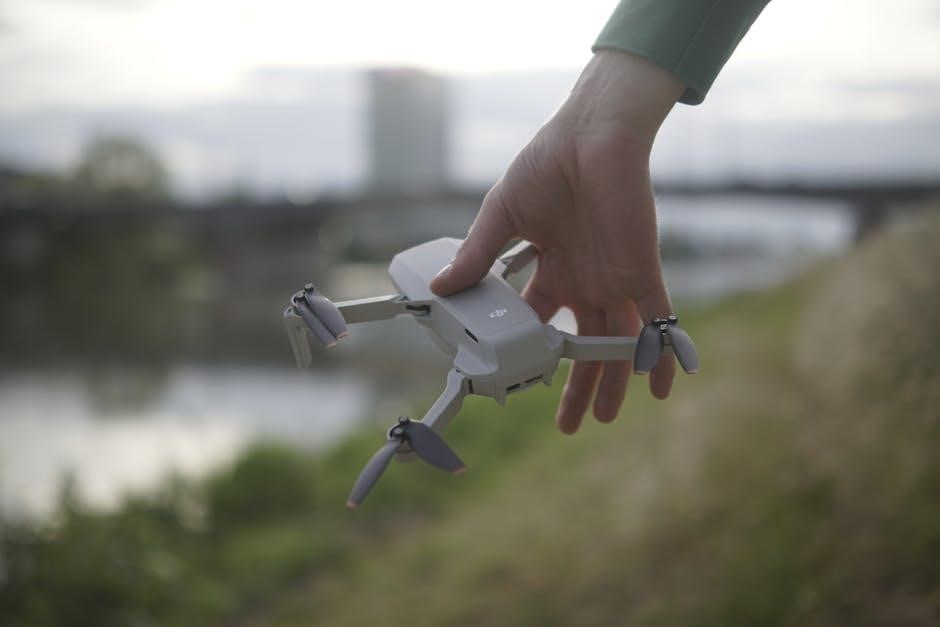
Understanding Drone Components
Understanding drone components is crucial for optimal performance․ Key parts include motors, propellers, ESCs, flight controllers, and sensors․ Familiarize yourself with each component’s function to ensure safe and efficient operation․
3․1 Hardware Components
Drone hardware components include motors, propellers, ESCs (Electronic Speed Controllers), and a flight controller․ These work together to enable flight․ Additional components like GNSS modules and vision systems enhance navigation and stability, allowing for precise hovering and aerobatic maneuvers․ Regular maintenance, such as inspecting propellers and updating firmware, ensures optimal performance․ Understanding each part’s function is essential for troubleshooting and upgrading your drone effectively․
3․2 Software and Firmware
Drone software and firmware are crucial for managing flight systems, processing data, and enabling advanced features․ Modern drones utilize AI models like OpenAI o3 and o4-mini for visual reasoning and autonomous flights․ Firmware updates enhance performance and security, while libraries like bqb and buildsqlx support database queries․ Tools like Pix4D process aerial data, and systems like DeepSeek generate synthetic data for training․ Regular updates and understanding software integration are vital for optimal drone operation and customization․
3․3 Sensors and Navigation Systems
Drones rely on advanced sensors and navigation systems to ensure precise flight control and stability․ These systems include GNSS for GPS navigation and Vision Systems that enable obstacle detection and stable hovering․ Sensors collect real-time environmental data, while navigation systems process this information to guide the drone․ Together, they allow seamless operation in both indoor and outdoor environments, ensuring smooth aerobatic maneuvers and efficient mission execution․ Regular calibration of these systems is essential for optimal performance․
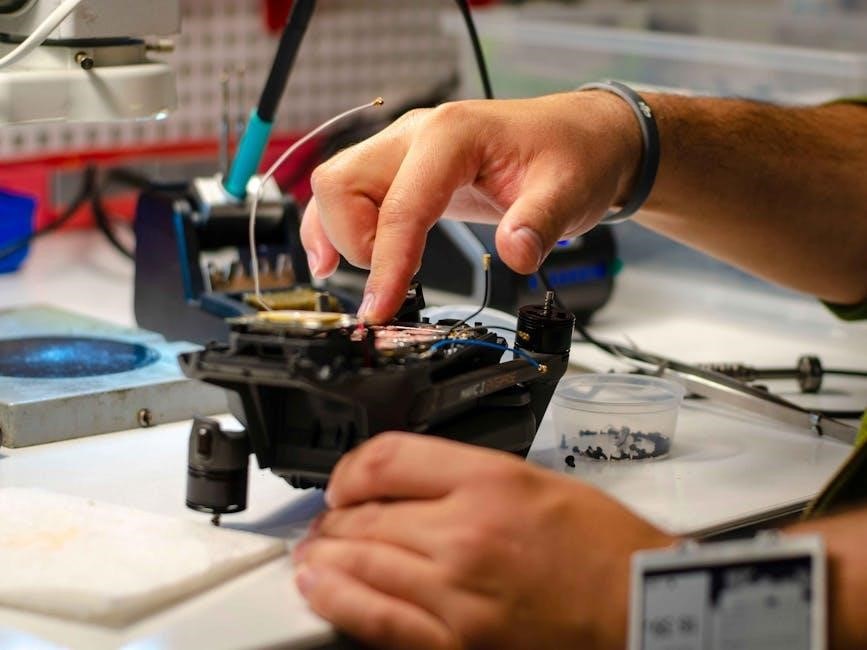
Drone Assembly and Setup
Welcome to the Drone Assembly and Setup section․ This guide covers unpacking, inventory, step-by-step assembly, and initial configuration to ensure a smooth and safe flight experience․
4․1 Unpacking and Inventory
Begin by carefully unpacking your drone and ensuring all components are included․ Check for the aircraft, remote controller, batteries, propellers, and documentation․ Verify the integrity of each item for damage or defects․ Refer to the provided manual for a detailed inventory list․ Organize the components securely to avoid loss․ Familiarize yourself with the drone’s accessories, such as chargers and tools, before proceeding to assembly․
4․2 Step-by-Step Assembly
Start by attaching the propellers to the motors using the provided tools․ Secure the motor mounts and ensure all connections are tight․ Next, install the flight controller and connect it to the drone’s frame․ Mount the camera and sensors, following the manual’s alignment guide․ Insert the battery and connect it to the power hub․ Finally, activate the drone through the remote controller or software․ Double-check all connections for safety and proper functionality․
4․3 Initial Configuration
Install the drone’s software and update the firmware to the latest version․ Calibrate the compass, IMU, and GPS for accurate navigation․ Pair the remote controller with the drone and configure the flight modes․ Set up the camera settings and ensure all sensors are functioning properly․ Activate the drone through the software and perform a system test to verify all components are working correctly before the first flight․
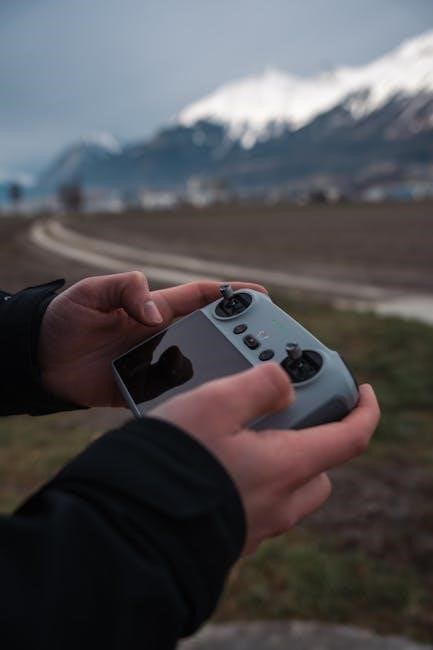
Basic Flight Training
Master essential flying skills, starting with understanding controls and hovering․ Practice basic maneuvers like takeoff, landing, and navigation․ Build confidence in handling your drone safely and effectively․
5․1 Understanding Controls
Mastering drone controls is crucial for safe and effective flight․ The primary control sticks manage throttle, yaw, pitch, and roll․ The left stick typically controls altitude and rotation, while the right stick handles forward, backward, and side-to-side movements․ Additional buttons may adjust camera angles or activate specific modes․ Familiarize yourself with the controller layout and practice basic movements in an open area to build confidence and precision․
5․2 Hovering and Basic Maneuvers
Mastering hovering is essential for stable flight․ Start in an open area, use gentle throttle adjustments to maintain altitude, and practice holding position․ Basic maneuvers include moving forward, backward, and sideways by adjusting pitch and roll․ Use yaw to rotate the drone while hovering․ Gradually increase speed and precision as you gain confidence․ Smooth, deliberate movements are key to maintaining control and avoiding obstacles during flight․
5․3 Emergency Procedures
In emergency situations, prioritize landing safely․ Use RTK for precise positioning and activate AI systems to predict and mitigate risks․ Ensure synthetic data is available for quick decision-making․ Always follow activation procedures to maintain system readiness․ Utilize natural language control for rapid command execution․ Stay informed about industry standards to handle emergencies effectively․ Keep emergency protocols handy for quick reference during critical moments to ensure safe outcomes․
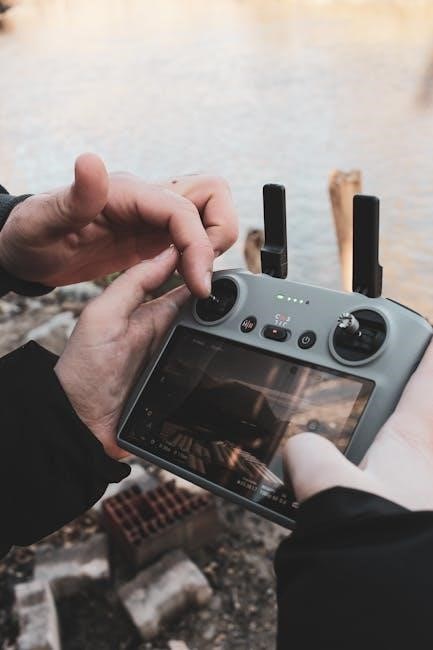
Advanced Flight Techniques
Master aerobatic maneuvers and long-range flying using cutting-edge AI․ Utilize RTK for precise navigation and synthetic data for enhanced performance․ Explore flying in diverse weather conditions for improved adaptability․
6․1 Aerobatic Maneuvers
Aerobatic maneuvers involve advanced drone movements like flips, rolls, and dives․ These techniques require precise control and practice․ Use AI-enhanced systems for smoother execution․ RTK drones and synthetic data improve accuracy․ Start with basic flips, then progress to complex patterns․ Always practice in open spaces and use simulation modes to refine skills before real flights․ Mastering these maneuvers enhances your drone handling and creativity․
6․2 Long-Range Flying
Long-range flying requires careful planning and equipment setup․ Ensure your drone has an extended range antenna and high-capacity battery․ Use RTK technology for precise navigation and stability․ Plan waypoints in advance using tools like Pix4D․ Monitor weather conditions and maintain line of sight․ Utilize AI-enhanced systems for real-time adjustments․ Always check local regulations for restricted zones․ Practice in open areas to maximize range and efficiency during flights․
6․3 Flying in Different Weather Conditions
Flying in various weather conditions demands adaptability and caution․ Avoid rain or snow, as they can damage electronics․ Strong winds require reduced speed and precise control․ Use GNSS and vision systems for stability․ High temperatures may reduce battery life, while cold weather can affect performance․ Always check forecasts and adjust settings for optimal flight․ Practice in mild conditions before tackling extreme weather․ Utilize AI-enhanced systems for real-time stability adjustments․ Ensure your drone is weather-sealed for safe operation․ Calibrate sensors regularly for accurate navigation in all conditions․ Follow manufacturer guidelines for temperature and humidity limits to maintain reliability and safety during flights․
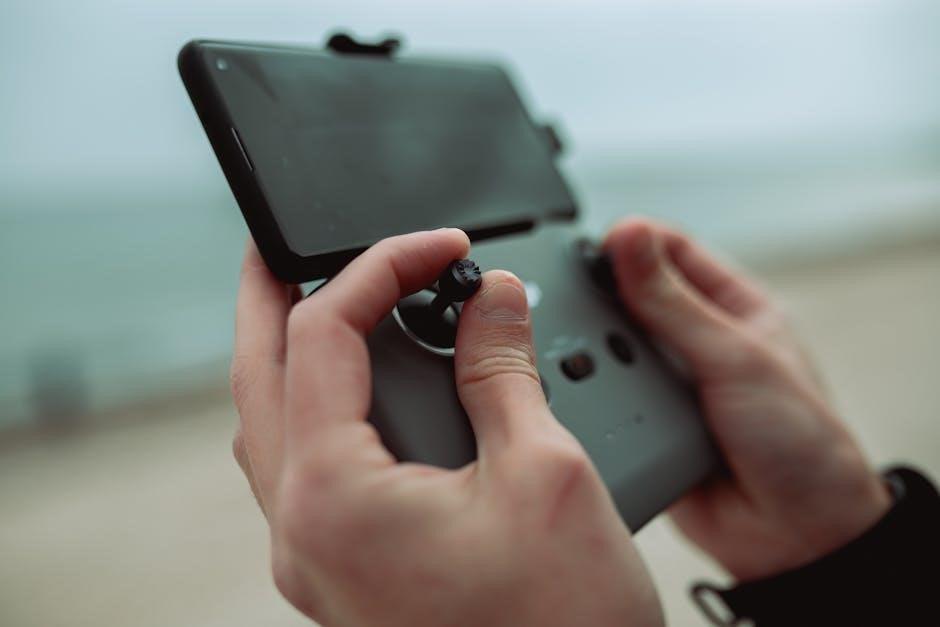
Drone Maintenance
Regular maintenance ensures optimal performance and longevity․ Clean and inspect components, address minor issues promptly, and upgrade parts as needed for enhanced functionality and safety․
7․1 Regular Maintenance Checks
Regular maintenance is crucial for ensuring your drone operates safely and efficiently․ Always start with a pre-flight inspection, checking for damage or wear on propellers, motors, and hinges․ Clean the camera lens and sensors to avoid interference․ Update software and firmware regularly to access the latest features and security patches․ Inspect the battery for swelling or damage and ensure proper storage․ Schedule professional checks annually for complex systems․
7․2 Troubleshooting Common Issues
Identify symptoms like erratic flight or loss of signal․ Check for error messages and ensure firmware is updated․ Recalibrate sensors and inspect propellers for damage․ Verify battery health and connections․ Consult the manual for specific solutions or contact support for persistent issues․ Regular checks can prevent major malfunctions, ensuring safe and reliable operation․
7․3 Upgrading and Customizing
Enhance your drone’s performance by upgrading hardware, such as motors or propellers, and installing custom accessories․ Update firmware regularly for improved functionality․ Customize settings like flight modes or camera configurations to suit your needs․ Always follow manufacturer guidelines to ensure compatibility and safety․ Experiment with third-party software for advanced features, but verify reliability․ Personalize aesthetics with custom designs or paint jobs for a unique look․
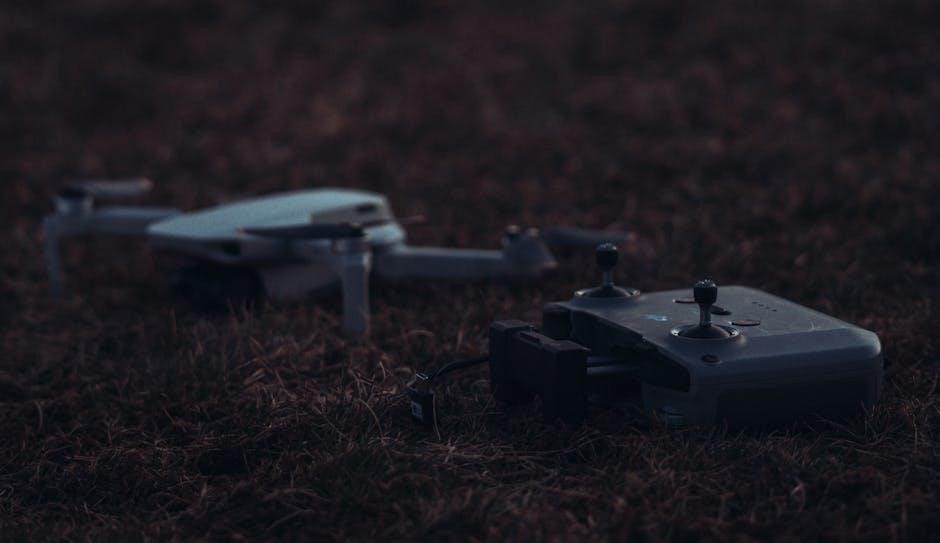
Legal Considerations
Understand drone regulations, licensing requirements, and privacy laws to ensure legal compliance․ Familiarize yourself with no-fly zones and ethical guidelines for responsible drone operation․
8․1 Regulations and Licensing
Familiarize yourself with local drone regulations and licensing requirements․ Laws vary by region, often mandating pilot certification and aircraft registration․ Ensure compliance to avoid legal penalties and ensure safe operations․ Always verify with aviation authorities for the latest updates on drone legislation in your area․
8․2 No-Fly Zones
Understand and respect no-fly zones, which are areas where drone operation is prohibited or restricted․ These include airports, government buildings, stadiums, and sensitive infrastructure․ Use official maps or apps to identify these zones․ Always check local regulations to ensure compliance and avoid legal issues․ Violating no-fly zones can result in fines or penalties, so plan your flights responsibly and stay informed․
8․3 Privacy and Ethical Considerations
Respecting privacy and ethical standards is crucial when operating a drone․ Avoid capturing sensitive or personal information without consent․ Be mindful of filming in private spaces or over populated areas․ Always adhere to local privacy laws and ethical guidelines to ensure responsible drone use․ Remember, drones with cameras can infringe on privacy rights if not used thoughtfully․ Ethical flying practices are key to maintaining public trust in drone technology․

Drone Programming
Drone programming allows users to customize flight paths and enable autonomous missions․ Using AI and machine learning, drones can perform complex tasks, enhancing their functionality and capabilities significantly․
Drone programming involves designing and implementing algorithms to control drone behavior․ Using AI and machine learning, users can create autonomous missions, process sensory data, and enable real-time decision-making․ This section introduces the basics of drone programming, including the use of libraries, query builders, and AI models like OpenAI’s o3 and o4-mini for advanced functionalities, helping you unlock your drone’s full potential through customization and automation․
9․2 Using AI for Autonomous Flights
AI enables drones to perform autonomous missions by processing sensory data and making real-time decisions․ Advanced models like OpenAI’s o3 and o4-mini use visual reasoning to interpret environments․ Generative AI creates synthetic data for training, while reinforcement learning optimizes flight paths․ These technologies allow drones to adapt to dynamic conditions, ensuring precise navigation and execution of complex maneuvers, enhancing safety and efficiency in autonomous operations․
9․3 Customizing Flight Paths
Customizing flight paths allows users to tailor drone missions to specific needs․ Using AI-powered tools, pilots can design intricate routes, incorporating waypoints and altitude adjustments․ Advanced systems enable real-time modifications based on environmental data․ Generative AI assists in optimizing paths for efficiency and obstacle avoidance․ This feature is particularly useful for mapping, surveillance, and autonomous operations, ensuring precise execution and adaptability in diverse scenarios while adhering to safety and legal standards․
Thank you for exploring the Drone Manual․ Advances in AI and programming are reshaping drone capabilities․ Keep innovating and flying safely!
10․1 Summary of Key Points
This manual covered essential aspects of drone operation, from safety guidelines and component understanding to advanced flight techniques․ It emphasized the importance of pre-flight checks, legal compliance, and regular maintenance․ Additionally, the integration of AI and programming for autonomous flights was highlighted, showcasing the evolving nature of drone technology․ These key points ensure a comprehensive understanding for both beginners and experienced pilots․
10․2 Future of Drone Technology
The future of drone technology promises exciting advancements, including enhanced AI integration for autonomous flights and improved computer vision systems․ With models like OpenAI’s o3 and o4-mini enabling visual reasoning, drones will perform complex tasks with greater precision․ Regulations are expected to evolve, ensuring safer and more efficient operations․ As synthetic data and reinforcement learning advance, drones will become indispensable in industries like surveying, delivery, and surveillance, revolutionizing how we live and work․

